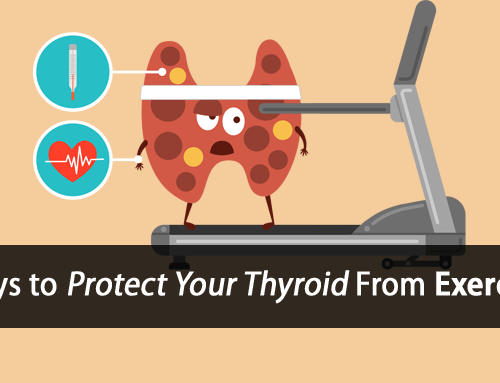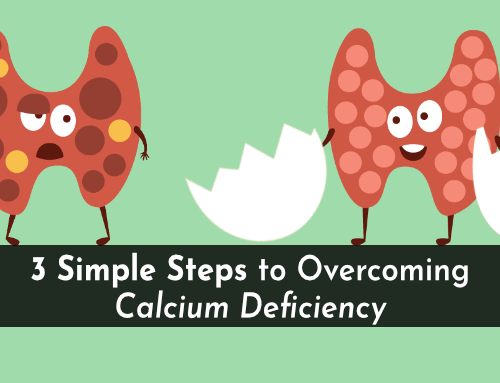This isn’t something you see every day.
So, it makes for an interesting case study.
There’s a lot going on here, including a case of hypothyroidism and high T3.
When working with clients, we typically discuss health history, symptoms, lab work, etc. in order to help paint the bigger picture of what’s really happening in the body.
We then take all of that information and look for patterns and clues that point to certain common hormonal and metabolic dysfunctions.
Oftentimes we find many indicators that all point to the same problem(s).
Sometimes the answers are less obvious. In these cases, we have to narrow down the culprits and do some experimentation in order to isolate the problem(s).
Let’s see what sense we can make of this interesting case.
Hypothyroidism and High T3 Case Study Background
This case study is a 64 year old post menopausal female experiencing many thyroid symptoms including:
- Excess Abdominal Fat
- Hypertension
- Low Body Temperature
- Always Cold
- Thinning Eyebrows
- Restless Sleep
- Fatigue
- Muscle Weakness
- Difficulty Concentrating
The following are the pertinent lab results for discussion:
- TSH – <0.005 IU/mL (0.450 – 4.50)
- T4, free – 1.26 ng/dL (0.82 – 1.77)
- T3 – 204 ng/dL (71 – 180)
- Reverse T3 – 17.0 ng/dL (9.2 – 24.1)
- Cholesterol, Total – 238 mg/dL (100 – 199)
- Triglycerides – 401 mg/dL (0 – 149)
The subject currently uses 2.5 grains of Nature-throid and additional desiccated thyroid multi-dosed throughout the day.
The subject is concerned about their abnormal thyroid hormone labs.
Temperature and Pulse are as follows:
- Basal Waking Temperature – Consistently low and fluctuates on a daily basis between 96.5 F (35.8 C) and 97.7 F (36.5 C).
- Post Breakfast Temperature – Often drops to below Basal Waking Temperature indicating elevated nighttime/morning stress hormones.
- Afternoon Temperature – Consistently low, never rising above 97.7 F (36.5 C).
Interesting Thyroid Observations, Patterns, and Clues
The first things to stand out in this case were the common symptoms associated with elevated cortisol, which is common in hypothyroidism.
- Excess Abdominal Fat
- Hypertension
- Elevated Cholesterol
- Elevated Triglycerides
- Post Breakfast Body Temperature Drop
This elevated cortisol is something that will be mentioned throughout the case study, as you’ll see in a minute.
I also suspect, given the symptoms above, that there is some degree of insulin resistance, which is also commonly found in cases of elevated cortisol.
Additional testing may be needed to determine this.
Hypothyroidism and High T3
According to the lab values provided above, particularly the elevated T3, the subject would likely be incorrectly diagnosed as hyper-thyroid by their doctor.
While her T3 levels are above the recommended reference range, it’s important to ALWAYS observe symptoms along with temperature and pulse when assessing thyroid function.
Want to learn how to do this yourself?
I cover everything you need to know about thyroid testing and more in this FREE training called The Ultimate Thyroid Testing Protocol.
You can access this training here.
Her basal morning body temperature is consistently low and never reaches close to normal throughout the day.
If she were truly hyper-thyroid, her body temperature would be above normal, not suppressed.
She would also exhibit hyper-thyroid symptoms instead of the common hypothyroid symptoms of which she complains, such as always feeling cold.
When we see high T3 levels and low body temperature, we know that thyroid hormone (T3) is being blocked and not being used properly.
In some cases, we find this being caused by either low cholesterol or low vitamin A, yet both have been ruled out in this case.
Her reverse-T3 is higher than we like to see, which can be another factor.
Ideally we like to see reverse-T3 at the low end of the reference range.
It often increases in response to stress in an attempt to reserve energy by inhibiting metabolism and the use of T3.
The suspected elevated cortisol mentioned above is likely at play here.
Elevated cortisol will block thyroid function at the liver by increasing the conversion of inactive thyroid hormone (T4) into reverse-T3.
Because of this, the subject would likely be a good candidate for T3-Only thyroid hormone therapy.
Her TSH is suppressed, which we would expect given the amount of thyroid hormone she is using.
This isn’t a concern and is often desirable.
Hypothyroidism and High Triglycerides
Triglycerides are often misunderstood but can be a very telling sign of thyroid and metabolic dysfunction.
When you consume carbohydrates, they are first and foremost metabolized and used for energy production.
What carbohydrates are not required for energy production are then stored in the liver in the form of glycogen.
Think of glycogen as your fuel reserves that are stored and used between meals and during the night when you’re not eating anything.
Your liver needs usable thyroid hormone (T3) along with other nutrients in order to store and release glycogen.
Keep in mind that this client is using T3 properly.
Carbohydrates that aren’t used for energy or stored in the liver as glycogen are then converted into the storage form of fatty acids known as triglycerides.
What’s interesting is that the subject’s triglycerides are extremely elevated, above 400.
While triglycerides themselves aren’t necessarily dangerous, they can help explain the underlying dysfunctions that are the real problem.
In this case, it’s a sign of impaired oxidative metabolism, potential insulin resistance, and likely issues with the liver storing and releasing glycogen.
In other words, if you can’t metabolize carbohydrates or store them in your liver, then your body has no choice but to store them as triglycerides.
The elevated cortisol does come into play here as well.
Cortisol’s primary function is to break down muscle tissue protein and convert it into glucose/carbohydrate.
This is likely raising the subject’s blood sugar/glucose. Yet, since she can’t metabolize that glucose, it’s being forced into storage as even more triglycerides.
It’s also worth noting that if excessive protein is being broken down, it can limit the amount of protein available to support liver and thyroid function.
So, getting adequate dietary protein becomes increasingly important as well.
Focus should be placed on restoring healthy oxidative metabolism, which will likely correct the high triglycerides.
Case Study Recommendations
As mentioned previously, the subject may be a good candidate for T3-Only thyroid hormone therapy.
But there’s a lot more than can be done as well.
Focus should be placed on determining the underlying cause of the elevated cortisol, such as blood sugar instability, excessive exercise, estrogen dominance, elevated serotonin, etc.
Hypothyroidism is a common cause of blood sugar instability, so further observation of dietary practices should be done to determine if this is a probable cause.
The subject mentioned exercising by hiking anywhere from 5-10 miles and experiencing fatigue within a couple of hours.
This would be considered excessive exercise for just about any hypothyroidism sufferer and can stimulate significant cortisol production.
Serotonin is another common cause of elevated cortisol, which I suspect may be an issue given some of the subject’s other symptoms.
It may be worth testing for serotonin to confirm or rule it out.
It would also be important to ensure that adequate protein was being consumed.
Focus should also be placed on improving liver health, restoring oxidative metabolism, and improving insulin resistance.
To do this, we would first focus on B-Vitamins, particularly Thiamine (Vitamin B1), Niacinamide (Vitamiin B3), and Biotin (Vitamin B7), all found in our Vitamin B Thyroid Complex.
Higher therapeutic doses of Niacinamide (Vitamin B3) may be necessary.
(Note: Want to learn more about the benefits of Thiamine (Vitamin B1)? Take a look at this post on “Thiamine and Thyroid: 3 Hidden Thyroid Benefits You Don’t Want to Miss”.)
In addition, stimulating healthy oxidative metabolism through the use of coffee/caffeine, magnesium, and calcium can be helpful.
Click here for additional resources on magnesium.
Click here for additional resources on calcium.
Aside from the additional testing that may prove helpful, we would work on implementing these recommendations as a starting point while continuing to observe temperature and pulse throughout the process.
We would then retest after two to three months to observe changes and further fine-tune the recommendations based on the results.
As you can see, there’s a lot that we can learn from observing symptoms and labs and interpreting them with respect to temperature and pulse.
By doing so, we can often discover the underlying the hidden underlying issues that we can then correct to help restore thyroid function and metabolism.
Want a simple way to get started yourself?
I cover everything you need to know about thyroid testing and more in this FREE training called The Ultimate Thyroid Testing Protocol.



You can access this training here.
It covers thyroid testing extensively and gives you the exact blueprint of where I always start when working with my clients.







Will I be able to loose weight eating this diet . I also am loosing hair , have bad dry skin and even scaly patches on my arms and legs , also all my nails are paper thin and broken . I’ve been on thyroid medicine for around 50 years . Its isnt working any more . Help
Thanks for this Tom. Very interesting. I’d love to read more case studies in the future, if you care to share them.
A post-menopausal and a peri-menopausal woman both have lowered progesterone, which could raise cortisol.
I agree. These case studies will help me try to figure out after 8 years why I can’t get off my WP Thyroid, can’t seem to lower my blood sugar, and fix my metabolism. I don’t eat sugar, processed foods, nor grains…but concentrate on healthy fats, grassfed/pasture raised proteins, berries, green apples, mineral supplementation, oodles of supplements to support adrenals, chelate the heavy metals, removed amalgams through biological dentist, etc. Just found out I have Epstein-Barr Virus, so maybe this is the reason my thyroid numbers drop when I try to drop my WP Thyroid med. I’m tired of being fat. So, again, THANKS TOM! I’m always on the look-out for anything else I can do to stop this madness in my body, and these case studies are VERY helpful!
Ooops, one more comment. I’ve also been able to drop my TGB antibodies from over 400 down to 3. TPO has never been an issue….but again, can’t seem to get my blood sugar and metabolism fixed…and get off WP Thyroid medication. Grrrrrrr
Thanks for the excellent video. I’m looking forward to receiving the next two. I’m currently being tested for hypothyroidism and Hashimoto. My blood tests seem to be normal but I have all the symptoms of hypothyroidism. I feel terrible but it’s hard to get doctors to agree on what’s wrong with me. I have been on meds for over ten years but in the last few years my body is going crazy. Thanks again for the information.
Thank you for another amazing info.
I’m on your Hypothyroid Revolution diet plan and bought all the supplements and I’m doing just great finally and trying to tune in my needs day by day.
What is your thoughts about Black seed supplements (nigella sativa)? I see there is this new trend, they advertise it as a solution literally for everything. Is it safe in your opinion?
Thanks for everything